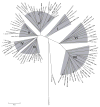Illuminating the diversity of aromatic polyketide synthases in Aspergillus nidulans
- PMID: 22510154
- PMCID: PMC3357392
- DOI: 10.1021/ja3016395
Illuminating the diversity of aromatic polyketide synthases in Aspergillus nidulans
Abstract
Genome sequencing has revealed that fungi have the ability to synthesize many more natural products (NPs) than are currently known, but methods for obtaining suitable expression of NPs have been inadequate. We have developed a successful strategy that bypasses normal regulatory mechanisms. By efficient gene targeting, we have replaced, en masse, the promoters of nonreducing polyketide synthase (NR-PKS) genes, key genes in NP biosynthetic pathways, and other genes necessary for NR-PKS product formation or release. This has allowed us to determine the products of eight NR-PKSs of Aspergillus nidulans, including seven novel compounds, as well as the NR-PKS genes required for the synthesis of the toxins alternariol (8) and cichorine (19).
Figures





References
-
- Galagan JE, Calvo SE, Cuomo C, Ma LJ, Wortman JR, Batzoglou S, Lee SI, Basturkmen M, Spevak CC, Clutterbuck J, Kapitonov V, Jurka J, Scazzocchio C, Farman M, Butler J, Purcell S, Harris S, Braus GH, Draht O, Busch S, D’Enfert C, Bouchier C, Goldman GH, Bell-Pedersen D, Griffiths-Jones S, Doonan JH, Yu J, Vienken K, Pain A, Freitag M, Selker EU, Archer DB, Penalva MA, Oakley BR, Momany M, Tanaka T, Kumagai T, Asai K, Machida M, Nierman WC, Denning DW, Caddick M, Hynes M, Paoletti M, Fischer R, Miller B, Dyer P, Sachs MS, Osmani SA, Birren BW. Nature. 2005;438:1105–15. - PubMed
-
- Keller NP, Turner G, Bennett JW. Nat Rev Microbiol. 2005;3:937–47. - PubMed
-
- Scherlach K, Hertweck C. Org Biomol Chem. 2009;7:1753–60. - PubMed
Publication types
MeSH terms
Substances
Grants and funding
LinkOut - more resources
Full Text Sources
Other Literature Sources
Molecular Biology Databases
Research Materials
Miscellaneous

